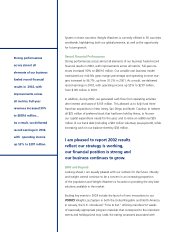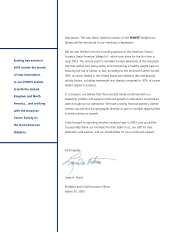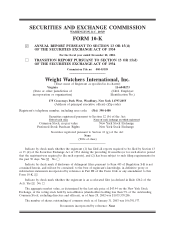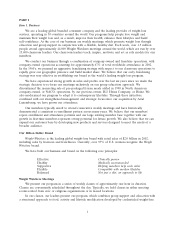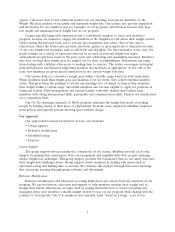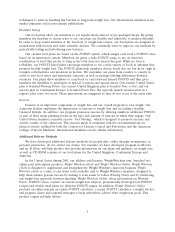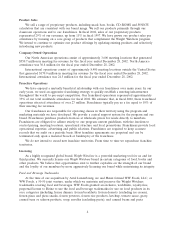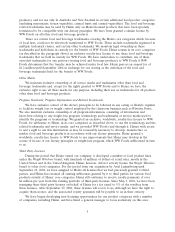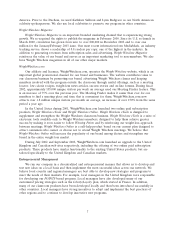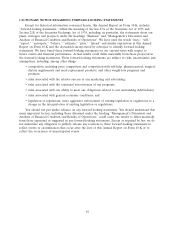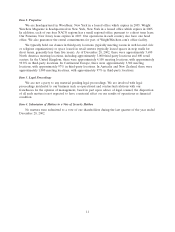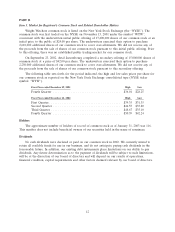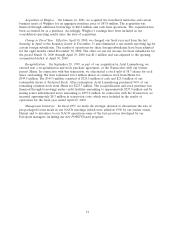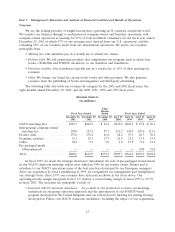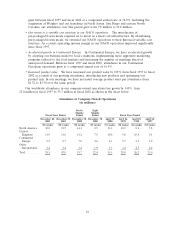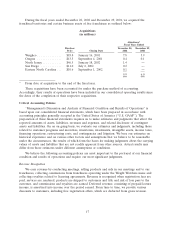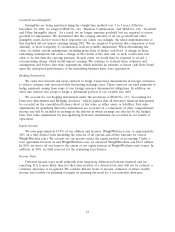WeightWatchers 2002 Annual Report Download - page 15
Download and view the complete annual report
Please find page 15 of the 2002 WeightWatchers annual report below. You can navigate through the pages in the report by either clicking on the pages listed below, or by using the keyword search tool below to find specific information within the annual report.Competition
The weight-loss market includes commercial weight-loss programs, self-help weight-loss products,
Internet-based weight-loss products, dietary supplements and meal replacement products, weight-loss
services administered by doctors, nutritionists and dieticians, surgical procedures and weight-loss drugs.
Competition among commercial weight-loss programs is largely based on program recognition and
reputation and the effectiveness, safety and price of the program. In the United States, we compete
with several other companies in the commercial weight-loss industry, although we believe that the
businesses are not comparable. For example, many of these competitors’ businesses are based on the
sale of pre-packaged meals and meal replacements. Our classes use group support, education and
behavior modification to help members change their eating habits, in conjunction with a flexible diet
that allows our members the freedom to choose what they eat. There are no significant group
education-based competitors in any of our major markets, except in the United Kingdom. Even there,
we have an approximately 50% market share and approximately twice the revenues of our largest
competitor, Slimming World.
We believe that food manufacturers that produce meal replacement products are not comparable
competition because these businesses’ meal replacement products do not engender behavior
modification through education in conjunction with a flexible, healthy diet.
History
Early Development
In 1961, Jean Nidetch, the founder of our company, attended a New York City obesity clinic and
took what she learned from her personal experience at the obesity clinic and began weight-loss
meetings with a group of her overweight friends in the basement of a New York apartment building.
Under Ms. Nidetch’s leadership, the group members supported each other in their weight-loss efforts,
and word of the group’s success quickly spread. Ms. Nidetch and Al and Felice Lippert, who all
successfully lost weight through these efforts, formally launched Weight Watchers in 1963.
Heinz Ownership
Recognizing the power of the Weight Watchers brand, Heinz acquired us in 1978 in large part to
acquire the rights to our name for its food business. Through the 1980s, we operated autonomously
under Heinz, maintaining our group education focus, and our business continued to grow.
In 1990, Heinz altered our successful model by introducing the sale of pre-packaged frozen meals
through our NACO operations in response to the initial success then experienced by some of our
competitors who focused on meal replacements. These changes forced our classroom leaders to become
food sales people and retail managers for food products, detracting from their function as role models
and motivators for our members. This caused a significant drop in customer satisfaction and employee
morale, and attendance in our NACO operations declined.
In 1995, we shifted to a more decentralized management approach, allowing the management of
our international operations to develop local business strategies and program innovations. This
approach was successful and by 1996 our international growth began to accelerate. Beginning in 1997,
we restructured our NACO operations by eliminating the pre-packaged frozen meals program from our
classroom operations, improving customer service, restoring employee morale and introducing a
POINTS-based program which had been successfully introduced in the United Kingdom. Following this
return to our core program approach in the United States, we moved from a fixed cost structure back
to a variable cost structure and have grown attendance in our NACO operations, excluding the impact
of our acquisitions, at a compound annual rate of 18.9% from fiscal 1997 to fiscal 2002.
8


